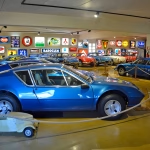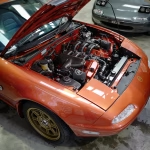More than 250 cars strong, the Louwman Museum in The Hague is replete with illustrious marques like Alfa Romeo, Bugatti, Delage, Delahaye, Duesenberg, Marmon, Minerva and Talbot-Lago. But what may be the most important car in the museum comes from more humble roots: It is a 1914 Dodge Brothers touring car, which has been part of the collection for 77 years.
The origins of the Louwman Collection date from 1934, when Evert Louwman’s father — the Hague-based Dutch Dodge (later Chrysler) distributor since 1923 — took the 1914 Dodge Brothers in trade. Today, the family business is distributing Toyotas, and the collection has grown dramatically in size and significance. No random collection, the cars within the Louwman Museum all tell a story and, according to Managing Director Ronald Kooyman, ‘give an overview of the whole motor industry’.

Located less than an hour from Amsterdam’s Schiphol Airport, the large museum fits beautifully into the elegant neighbourhood that is also home to Queen Beatrix of the Netherlands. American architect Michael Graves was responsible for a building that echoes the traditional Dutch architecture of the neighbourhood, but on a larger scale. The landscaping by Lodewijk Baljon is lush, and although you can see the building from the passing motorway, its scale is effectively disguised.
From the parking garage under the building, visitors walk around the front of the museum to face a U-shaped structure that mimics the traditional Dutch ‘Landhaus,’ with its jutting carriage house and stables on either side, connected by a central great hall. Enter the two-story museum building and you first see the reception area with a small gift shop to the right of it. Next comes the expansive great hall — often home to special exhibits — and, at the time of our visit, displaying representative cars from the around the world, including a Corvette from the United States, a Jaguar XK 120 from England, a Toyota 2000GT from Japan and a Tatra from what is now the Czech Republic.
The ground floor of the museum features several conference rooms, a theatre that seats 340 people and has a stage through which a car may be raised, and the great hall, which can accommodate dinner for 1,000 people. This floor may be the financial anchor of the museum, attracting 40,000 conference and meeting-goers annually (out of 100,000 visitors yearly), but for someone visiting to see the automobiles, the heart of the museum is the top two floors, where the major exhibits are located. An early Dutch carriage, a sedan chair and several wagons lead the visitor into a corridor of very early machines from Peugeot, Benz and Panhard et Levassor, which are part of a selection of carefully preserved pioneering horseless carriages. Presented chronologically, these machines tell the story of the birth of the automobile. However, Evert Louwman, who curated the exhibits himself with the assistance of Managing Director Kooyman, isn’t a slave to chronology, separating out tangential themes — such as steam, electric and hybrid cars, brass and vintage, single-seaters, cycle cars, bubble cars, aerodynamic cars, racing machines and those owned by important people — which might be minimized were they intermingled with main time-based themes that begin with ‘The Dawn of Motoring’ and end with ‘1945–1970’.
The most important automobiles are found within the themes, regardless of their origin. There’s a Model T Ford, a Volkswagen Beetle, important designs from the Chrysler Airflow to a Talbot-Lago teardrop coupe by Figoni et Falaschi, and another car with great personal significance to Louwman — a 1936 Toyota AA discovered in Siberia. To underscore that this is a Dutch museum, the collection includes 13 of the 16 Spykers known to survive, including the world’s first six-cylinder, all-wheel-drive racer, which dates from 1903.
Although cars are dominant, they aren’t alone in the museum: A wagon-maker’s workshop has been reassembled in the space, as has an early garage, and some of the original machine tools used to make the Spyker are on exhibit. Stairway landings display early bicycles, and Louwman also intersperses what must be the finest automobilia collection anywhere, thanks in part to the incorporation of the Raymond E. Holland Collection. There are posters dating to the beginning of the automobile, stained glass, porcelain, trophies, cigarette cases, toys and some fine original automotive pieces by the great names of automotive art, including Carlo Demand, Peter Helck, Walter Gotschke and F. Gordon Crosby. Not only are they beautifully displayed, the automobilia halls are used to hold visitors’ interest and add dimension to the collection.
According to Kooyman, the vast majority of the cars are maintained in operating condition. The original Mercedes-Benz SSK has been run in the Mille Miglia, the 1957 Le Mans-winning Jaguar D-Type has raced at Goodwood, and an Aston Martin DB3 is frequently driven by Louwman’s daughter in a variety of events.
After viewing the final exhibit, rather than being funneled out through the gift shop, the visitor exits into an early 20th century town square, complete with fascinating shop fronts, including a representation of the Louwman family’s original Dodge distributorship. The open square doubles as the seating area for the museum’s excellent café.
From the earliest horseless carriages to the humblest of Crosleys, a competition 2.9 Alfa Romeo and the truly absurd Brooke Swan Car, the Louwman Museum tells its story of the development of the automotive age effectively with colour, context and an undeniable joy. And to share that joy is well worth the trip, especially if you’re already in continental Europe.






